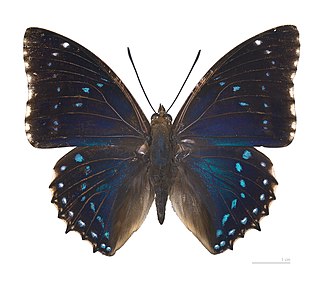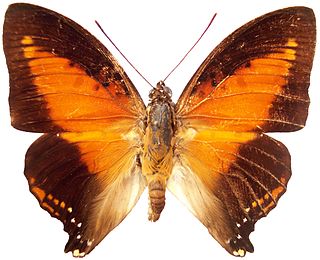
Eagle is the common name for many large birds of prey of the family Accipitridae. Eagles belong to several groups of genera, some of which are closely related. Most of the 60 species of eagle are from Eurasia and Africa. Outside this area, just 14 species can be found—2 in North America, 9 in Central and South America, and 3 in Australia.
Genus is a taxonomic rank used in the biological classification of living and fossil organisms as well as viruses. In the hierarchy of biological classification, genus comes above species and below family. In binomial nomenclature, the genus name forms the first part of the binomial species name for each species within the genus.

In taxonomy, binomial nomenclature, also called binominal nomenclature or binary nomenclature, is a formal system of naming species of living things by giving each a name composed of two parts, both of which use Latin grammatical forms, although they can be based on words from other languages. Such a name is called a binomial name, a binomen, binominal name or a scientific name; more informally it is also called a Latin name.

Anseriformes is an order of birds also known as waterfowl that comprises about 180 living species of birds in three families: Anhimidae, Anseranatidae, and Anatidae, the largest family, which includes over 170 species of waterfowl, among them the ducks, geese, and swans. Most modern species in the order are highly adapted for an aquatic existence at the water surface. With the exception of screamers, males have penises, a trait that has been lost in the Neoaves. Due to their aquatic nature, most species are web-footed.

Starlings are small to medium-sized passerine birds in the family Sturnidae. The name "Sturnidae" comes from the Latin word for starling, sturnus. Many Asian species, particularly the larger ones, are called mynas, and many African species are known as glossy starlings because of their iridescent plumage. Starlings are native to Europe, Asia and Africa, as well as northern Australia and the islands of the tropical Pacific. Several European and Asian species have been introduced to these areas as well as North America, Hawaii and New Zealand, where they generally compete for habitats with native birds and are considered to be invasive species. The starling species familiar to most people in Europe and North America is the common starling, and throughout much of Asia and the Pacific, the common myna is indeed common.

In zoological nomenclature, a type species is the species name with which the name of a genus or subgenus is considered to be permanently taxonomically associated, i.e., the species that contains the biological type specimen(s). A similar concept is used for suprageneric groups and called a type genus.

Linaceae is a family of flowering plants. The family is cosmopolitan, and includes about 250 species in 14 genera, classified into two subfamilies: the Linoideae and Hugonioideae. Leaves of the Linaceae are always simple; arrangement varies from alternate to opposite or whorled. The hermaphroditic, actinomorphic flowers are pentameric or, very rarely, tetrameric.

Heterostyly is a unique form of polymorphism and herkogamy in flowers. In a heterostylous species, two or three morphological types of flowers, termed "morphs", exist in the population. On each individual plant, all flowers share the same morph. The flower morphs differ in the lengths of the pistil and stamens, and these traits are not continuous. The morph phenotype is genetically linked to genes responsible for a unique system of self-incompatibility, termed heteromorphic self-incompatibility, that is, the pollen from a flower on one morph cannot fertilize another flower of the same morph.
Hugonia macrophylla is a species of plant in the Linaceae family. It is endemic to Cameroon. Its natural habitat is subtropical or tropical moist lowland forests. It is threatened by habitat loss.

In biological classification, taxonomic rank is the relative level of a group of organisms in a taxonomic hierarchy. Examples of taxonomic ranks are species, genus, family, order, class, phylum, kingdom, domain, etc.

The Conservatoire botanique national de Mascarin is a national conservatory and botanical garden located at 2, rue du Père Georges, Colimaçons, Saint-Leu, Réunion, France. It is open daily except Monday; an admission fee is charged.
Thalamiflorae is a historical grouping of dicotyledons, arranged in the De Candolle system and in the Bentham and Hooker system. This group was named and published well before internationally accepted rules for botanical nomenclature. In these systems, a family was indicated as "ordo", and modern rules of botanical nomenclature accept that as meaning a family rather than an order.Article 18.2 Family names have also since been standardized.

Charaxes lucretius, the violet-washed charaxes or common red charaxes, is a butterfly in the family Nymphalidae.

Charaxes numenes, the lesser blue charaxes, is a butterfly in the family Nymphalidae. It is found in Senegal, Guinea-Bissau, Guinea, Sierra Leone, Liberia, Ivory Coast, Ghana, Benin, Nigeria, Equatorial Guinea, Cameroon, Gabon, the Republic of the Congo, Angola, the Democratic Republic of the Congo, Zambia, the Central African Republic, Sudan, Ethiopia, Uganda, Kenya and Tanzania. The habitat consists of evergreen lowland forests.

Charaxes zingha, the shining red charaxes, is a butterfly in the family Nymphalidae. It is found in Senegal, Guinea, Sierra Leone, Liberia, Ivory Coast, Ghana, Nigeria, Cameroon, the Republic of the Congo, Angola, the Central African Republic, the northern part of the Democratic Republic of the Congo, Uganda and western Tanzania. The habitat consists of lowland evergreen forests and sometimes gallery forests and coastal scrubland.
Meza indusiata, the snowy missile, is a butterfly in the family Hesperiidae. It is found in Senegal, Guinea-Bissau, Sierra Leone, Liberia, Ivory Coast, Ghana, Nigeria, Cameroon, Gabon, the Republic of the Congo, Angola, the Democratic Republic of the Congo and Uganda. The habitat consists of forests.
Neoblastobasis perisella is a moth in the family Blastobasidae. It is found in Kenya and the Democratic Republic of the Congo, where it is known from coastal lowland habitats.

Hugonia mystax is a species of plant in the family Linaceae found mainly in the dry forests of peninsular India and Sri Lanka. It is a scandent shrub, sometimes growing liana-like over other trees and bears yellow flowers and orange to red fruits in the rainy season. The branchlets are leafless at the base and instead have a pair of recurved spines which bear a resemblance to a moustache, giving rise to the epithet mystax, Latin for moustache.
Hugonia planchonii is a liana with bright yellow flowers that are short-lived and stems producing alternate hooks that is endemic to countries in Tropical West Africa but also occurs in Cameroon and Gabon. It is within the Linaceae family.













